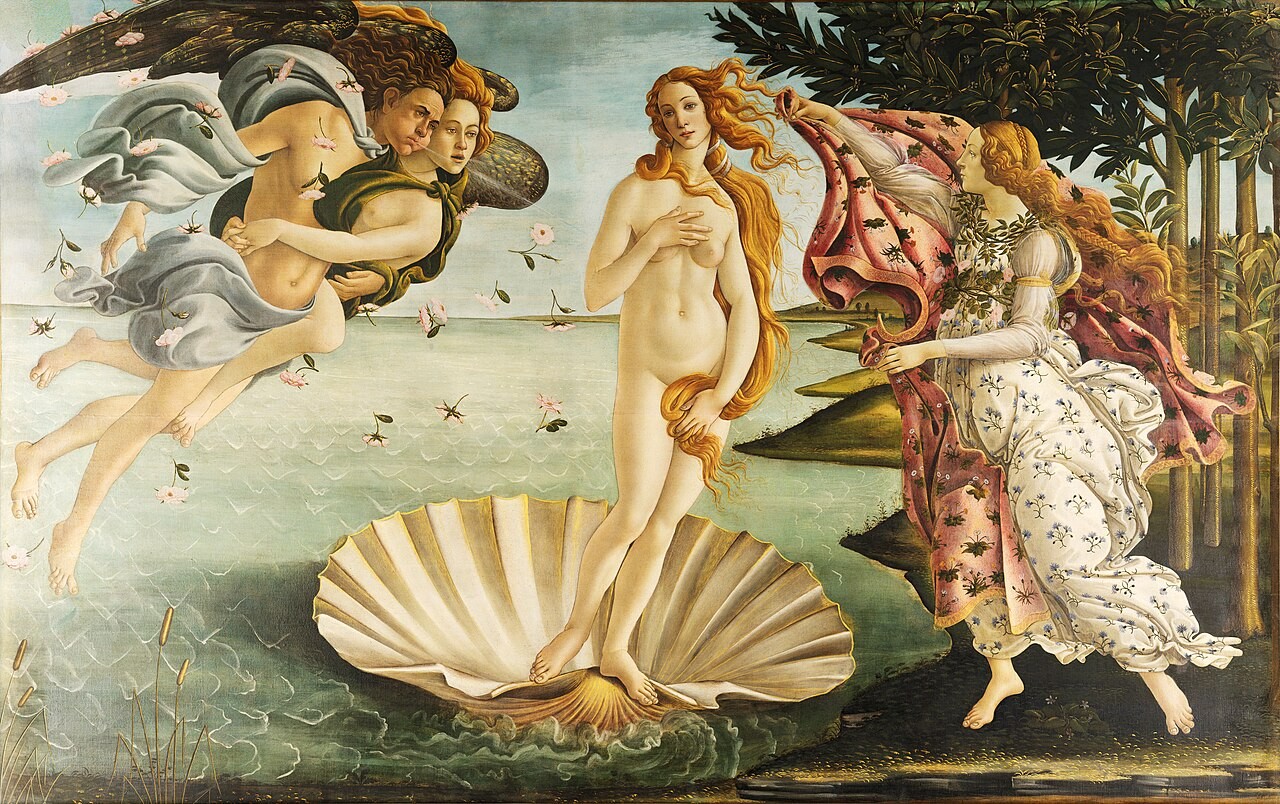Aphrodite, the goddess of love and beauty, holds a significant place in Greek mythology, and WHAT.EDU.VN is here to explore her story. Let’s delve into her origins, powers, and cultural significance, providing you with a comprehensive understanding of this iconic deity, ensuring clarity on her divine essence. Discover the captivating world of ancient Greek goddesses and their enduring influence.
1. Who Is Aphrodite And What Is She The Goddess Of?
Aphrodite is the ancient Greek goddess of love, beauty, pleasure, and procreation. Known as Venus in Roman mythology, she embodies feminine beauty and desire, influencing both mortals and gods.
Aphrodite’s domains include:
- Love: She governs all aspects of love, from romantic passion to familial affection.
- Beauty: As the epitome of beauty, she inspires aesthetics and admiration.
- Pleasure: Aphrodite is associated with joy, delight, and sensual experiences.
- Procreation: She oversees fertility and the cycle of life, ensuring continuity and growth.
2. What Are The Origins Of Aphrodite?
Aphrodite’s origin story varies, adding to her mystique and multifaceted nature. The most famous account is from Hesiod’s Theogony.
2.1 The Hesiod Account
According to Hesiod, Aphrodite was born from the sea foam (aphros) near Cyprus. This occurred after Cronus castrated Uranus, and his severed genitals fell into the sea. The foam gave rise to Aphrodite, who emerged fully formed, a symbol of beauty born from chaos.
2.2 The Homeric Account
In Homer’s Iliad, Aphrodite is depicted as the daughter of Zeus and Dione. This lineage places her among the Olympian gods, highlighting her power and status within the pantheon.
2.3 Eastern Influences
Some scholars propose that Aphrodite’s worship originated in the East, influenced by goddesses like Ishtar and Astarte. These ancient Middle Eastern deities share attributes related to love, fertility, and beauty, suggesting a cultural exchange that shaped Aphrodite’s character.
3. What Are Aphrodite’s Key Attributes And Symbols?
Aphrodite is often depicted with specific attributes and symbols that signify her powers and associations. These include:
- Myrtle: This evergreen shrub is sacred to Aphrodite, symbolizing eternal love and beauty.
- Roses: These flowers are closely linked to Aphrodite, representing love, passion, and beauty.
- Doves: These birds are often seen accompanying Aphrodite, symbolizing peace, love, and devotion.
- Swans: Known for their grace and beauty, swans are associated with Aphrodite, representing elegance and love.
- Seashells: As a goddess born from the sea, seashells are a natural emblem of Aphrodite’s origins and connection to the ocean.
4. What Role Does Aphrodite Play In Greek Mythology?
Aphrodite is a central figure in Greek mythology, involved in numerous stories and influencing the lives of gods and mortals alike.
4.1 The Judgment Of Paris
One of the most famous myths involving Aphrodite is the Judgment of Paris. In this tale, Paris, a Trojan prince, had to choose the fairest goddess among Aphrodite, Hera, and Athena. Aphrodite promised Paris the most beautiful woman in the world, Helen of Sparta, if he chose her. Paris selected Aphrodite, leading to the abduction of Helen and ultimately triggering the Trojan War.
4.2 Aphrodite And Adonis
The story of Aphrodite and Adonis is a tale of love and tragedy. Adonis, a strikingly handsome youth, captured Aphrodite’s heart. However, Adonis was killed by a boar while hunting, causing Aphrodite immense grief. According to the myth, his blood turned into anemone flowers, symbolizing the fleeting nature of beauty and life.
4.3 Aphrodite And Ares
Aphrodite’s affair with Ares, the god of war, is a scandalous yet compelling narrative. Married to Hephaestus, the blacksmith god, Aphrodite engaged in a secret love affair with Ares. Their relationship was eventually exposed by Helios, the sun god, who informed Hephaestus. Hephaestus crafted a cunning trap, ensnaring Aphrodite and Ares in a net for all the gods to witness, highlighting the consequences of infidelity.
Aphrodite’s affair with Ares, the god of war, is a scandalous yet compelling narrative.
5. How Was Aphrodite Worshipped In Ancient Greece?
Aphrodite was widely worshipped throughout ancient Greece, with various temples and festivals dedicated to her honor.
5.1 Temples And Sanctuaries
Major centers of Aphrodite’s worship included Paphos and Amathus on Cyprus, as well as Cythera and Corinth. These sites featured temples and sanctuaries where devotees would offer prayers, sacrifices, and gifts to the goddess.
5.2 Festivals And Rituals
Festivals such as the Aphrodisia were celebrated in honor of Aphrodite. These events included processions, sacrifices, and various forms of entertainment, reflecting the joy and pleasure associated with the goddess. Rituals often involved purification and offerings of flowers, incense, and myrtle wreaths.
5.3 Patronage Of Prostitutes
While Aphrodite was generally associated with solemn and respectable worship, she was also considered the patron goddess of prostitutes. This aspect of her cult reflects the ancient Greek view of sexuality and the diverse roles that Aphrodite embodied.
6. What Are Aphrodite’s Powers And Abilities?
As a goddess, Aphrodite possesses a range of powers and abilities that underscore her divine status.
6.1 Inherent Beauty And Charisma
Aphrodite’s most prominent power is her unparalleled beauty. She possesses the ability to captivate and enchant both gods and mortals, inspiring love and desire wherever she goes.
6.2 Influence Over Love And Desire
Aphrodite can manipulate the emotions of love and desire, stirring passions and influencing relationships. Her power extends to matchmaking and ensuring the fertility of individuals and communities.
6.3 Protection And Guidance
Sailors and travelers often sought Aphrodite’s protection, as she was also revered as a goddess of the sea. She could grant safe passage and favorable winds, ensuring successful voyages.
6.4 Limited Influence Over War
Despite not being primarily a war goddess, Aphrodite had some influence in matters of conflict, particularly through her son Eros, who could incite passionate fervor. Her association with Ares further connects her to the dynamics of war and passion.
7. How Is Aphrodite Depicted In Art And Literature?
Aphrodite has been a popular subject in art and literature throughout history, inspiring countless depictions and interpretations.
7.1 Classical Sculpture
In ancient Greek sculpture, Aphrodite is often portrayed as a beautiful, nude woman. The Aphrodite of Knidos by Praxiteles is one of the most famous examples, showcasing the goddess’s ideal form and sensuality. The Venus de Milo is another iconic representation, highlighting her timeless beauty.
7.2 Renaissance Paintings
Renaissance artists frequently depicted Aphrodite (Venus) in their works. Sandro Botticelli’s Birth of Venus is a prime example, portraying her emergence from the sea on a giant seashell, surrounded by Zephyrs and a Hora. The painting celebrates beauty, love, and the classical ideal.
7.3 Literary Representations
In literature, Aphrodite appears in numerous works, from Homer’s epics to later poems and plays. She is often depicted as a powerful and influential figure, capable of inspiring both great love and devastating conflicts. Her character is complex, embodying both the joys and sorrows of love.
 The Birth of Venus
The Birth of Venus
Sandro Botticelli’s Birth of Venus is a prime example, portraying her emergence from the sea on a giant seashell.
8. What Is The Significance Of Aphrodite’s Roman Counterpart, Venus?
In Roman mythology, Aphrodite is known as Venus. Venus holds a similar role to Aphrodite, embodying love, beauty, and fertility. However, Venus also took on additional significance as a symbol of Roman power and ancestry.
8.1 Venus Genetrix
Julius Caesar claimed Venus as his divine ancestor, constructing the Temple of Venus Genetrix in her honor. This association linked Venus to the Roman state, portraying her as the mother of the Roman people and a symbol of their divine right to rule.
8.2 Cultural Impact
The Roman Venus influenced art, literature, and culture throughout the Roman Empire and beyond. Her image was used to promote imperial power and celebrate Roman values. Venus’s enduring legacy is evident in countless works of art and literature that continue to celebrate her beauty and influence.
9. How Does Aphrodite Influence Modern Culture?
Aphrodite’s influence extends far beyond ancient Greece and Rome, permeating modern culture in various forms.
9.1 Art And Literature
Aphrodite continues to inspire artists and writers, appearing in contemporary novels, films, and visual arts. Her themes of love, beauty, and desire remain relevant and resonate with audiences today.
9.2 Popular Culture
In popular culture, Aphrodite’s name and image are often used in advertising, fashion, and beauty products. She is frequently invoked as a symbol of feminine beauty and allure.
9.3 Psychological Archetype
Aphrodite serves as a psychological archetype, representing the feminine principle of love, beauty, and creativity. Her influence can be seen in discussions of relationships, self-esteem, and the pursuit of aesthetic ideals.
10. What Are Some Lesser-Known Facts About Aphrodite?
Beyond the well-known myths and attributes, there are several lesser-known facts about Aphrodite that add depth to her character.
10.1 Aphrodite’s Connection To The Underworld
While primarily a goddess of love and beauty, Aphrodite had some connection to the underworld. Her association with Adonis, who spent part of the year in the realm of the dead, links her to the cycle of life and death.
10.2 Aphrodite As A Goddess Of War
In some regions, particularly Sparta, Aphrodite was worshipped as a goddess of war. This aspect of her cult reflects the ancient Greek understanding that love and beauty could be powerful forces in both creation and destruction.
10.3 Aphrodite’s Varied Epithets
Aphrodite was known by numerous epithets, each highlighting a different aspect of her character. These included Aphrodite Urania (Heavenly Aphrodite), Aphrodite Pandemos (Aphrodite of All the People), and Aphrodite Areia (Warlike Aphrodite), showcasing her multifaceted nature.
Aphrodite is often depicted with specific attributes and symbols that signify her powers and associations.
11. What Are The Different Interpretations Of Aphrodite’s Character?
Aphrodite’s character has been interpreted in various ways throughout history, reflecting changing cultural values and perspectives.
11.1 The Ideal Of Beauty
Historically, Aphrodite has been seen as the embodiment of ideal beauty, inspiring artists and writers to create works that celebrate aesthetic perfection.
11.2 The Power Of Love
Aphrodite also represents the power of love, both romantic and familial. Her influence extends to relationships and the bonds that connect individuals and communities.
11.3 The Dangers Of Desire
Some interpretations focus on the potential dangers of unchecked desire and the destructive consequences of unchecked passion. Aphrodite’s stories often highlight the complexities and challenges of love.
11.4 The Creative Force
More recently, Aphrodite has been viewed as a symbol of creativity and the feminine principle, inspiring individuals to embrace their artistic talents and express their unique perspectives.
12. FAQ About Aphrodite
| Question | Answer |
|---|---|
| What is Aphrodite’s Roman name? | Venus. |
| What is Aphrodite the goddess of? | Love, beauty, pleasure, and procreation. |
| Who are Aphrodite’s parents? | In Homer’s version, Zeus and Dione; in Hesiod’s version, she sprang from the sea foam created by Uranus’s severed genitals. |
| What are Aphrodite’s symbols? | Myrtle, roses, doves, swans, and seashells. |
| Who are Aphrodite’s famous lovers? | Ares, Adonis, and Anchises. |
| What is the Judgment of Paris? | A myth in which Paris chose Aphrodite as the fairest goddess, leading to the Trojan War. |
| Where were Aphrodite’s main temples located? | Paphos and Amathus on Cyprus, Cythera, and Corinth. |
| How does Aphrodite influence modern culture? | Through art, literature, popular culture, and as a psychological archetype. |
| What are some lesser-known facts about Aphrodite? | Her connection to the underworld, her worship as a war goddess in some regions, and her varied epithets. |
| How is Aphrodite depicted in art? | Often as a beautiful, nude woman, as seen in sculptures like the Aphrodite of Knidos and paintings like Botticelli’s Birth of Venus. |
13. Explore Your Questions With WHAT.EDU.VN
Do you find yourself grappling with complex questions and seeking clear, concise answers? Are you tired of sifting through endless search results without finding the information you need? At WHAT.EDU.VN, we understand the challenges of finding reliable information quickly and easily.
We offer a unique platform where you can ask any question and receive prompt, accurate responses from knowledgeable experts. Whether you’re a student tackling a homework assignment, a professional seeking insights for your work, or simply a curious individual eager to learn more about the world, WHAT.EDU.VN is here to help.
Our services are designed to provide you with:
- Fast and Accurate Answers: Get the information you need without delay.
- Expert Insights: Benefit from the knowledge of experienced professionals and subject matter experts.
- Free Consultations: Access free advice and guidance on a wide range of topics.
- Easy-to-Use Platform: Navigate our user-friendly website with ease.
- Community Support: Connect with others who share your interests and learn from their experiences.
Don’t let your questions go unanswered. Visit WHAT.EDU.VN today and experience the convenience of having a world of knowledge at your fingertips.
Ready to get started?
Ask your question now and unlock a world of information. Our team is standing by to provide you with the answers you need.
Contact us:
- Address: 888 Question City Plaza, Seattle, WA 98101, United States
- WhatsApp: +1 (206) 555-7890
- Website: WHAT.EDU.VN
Join the what.edu.vn community and discover the joy of learning without limits. We’re here to help you explore, understand, and thrive.

